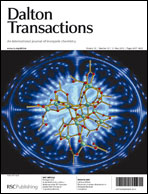The coordination chemistry of the ligand 3-(2-pyridyl)-[1,2,4]triazolo[4,3-a]pyridine (L10) has been investigated and iron(II), cobalt(II), nickel(II) and copper(II) complexes featuring diverse structural motifs have been prepared. In the 2 : 1-type complexes [CoII(L10)2(MeOH)2](ClO4)2 (20), [NiII(L10)2(MeOH)2](ClO4)2 (21), [CuII(L10)2(MeOH)2](ClO4)2 (22), [CoII(L10)2(H2O)2](ClO4)2 (23) and [CuII(L10)2(ClO4)2] (24) the metal centres are N4O2 octahedrally coordinated with two N2,Npyr bidentate ligands L10 in the equatorial positions. In the N6 octahedral 4 : 1-type complex [CoII(L10)4](ClO4)2·H2O (25) both axially coordinating N1 unidentate and equatorially bound N2,Npyr bidentate ligands L10 are observed. The N6 octahedral 3 : 1-type complex [FeII(L10)3](OTf)2·1.5MeCN·0.13H2O·0.87MeOtBu (27) features three N2,Npyr bidentate ligands L10 in the mer configuration. The two closely related N6 octahedral complexes [FeII(L10)2(NCS)2] (29) and [FeII(L10)2(dca)2] (30) have fundamentally different structures. While complex 29 features two equatorially bound N2,Npyr bidentate ligands L10 and axial NCS− co-ligands, complex 30 is a one-dimensional doubly μ1,5-dicyanamido-bridged polymer with N1 unidentate ligands L10 in the axial positions. Temperature-dependent magnetic susceptibility measurements of the iron(II) complexes 28 and 29 have shown the 3 : 1-type complex [FeII(L10)3](ClO4)2·H2O (28) to be in the low-spin state over the range 300–2 K and the 2 : 1-type complex 29 to be a spin crossover compound with T1/2 = 269 K whereas the dicyanamido-bridged complex 30 remains in the high-spin state even down to 113 K, according to X-ray diffraction data. A single end-to-end bridging NCS− co-ligand is found in the N4S square-pyramidal complex [CuII(L10)(NCS)2] (31) which shows Curie–Weiss behaviour over the range 300–2 K. A brief review of the coordination chemistry of triazolopyridines is given.
![Graphical abstract: Triazolopyridines as ligands: structural diversity in iron(ii), cobalt(ii), nickel(ii) and copper(ii) complexes of 3-(2-pyridyl)-[1,2,4]triazolo[4,3-a]pyridine (L10) and spin crossover in [FeII(L10)2(NCS)2]](/en/Image/Get?imageInfo.ImageType=GA&imageInfo.ImageIdentifier.ManuscriptID=B925107C&imageInfo.ImageIdentifier.Year=2010)
You have access to this article
 Please wait while we load your content...
Something went wrong. Try again?
Please wait while we load your content...
Something went wrong. Try again?
![Graphical abstract: Triazolopyridines as ligands: structural diversity in iron(ii), cobalt(ii), nickel(ii) and copper(ii) complexes of 3-(2-pyridyl)-[1,2,4]triazolo[4,3-a]pyridine (L10) and spin crossover in [FeII(L10)2(NCS)2]](/en/Image/Get?imageInfo.ImageType=GA&imageInfo.ImageIdentifier.ManuscriptID=B925107C&imageInfo.ImageIdentifier.Year=2010)

 Please wait while we load your content...
Please wait while we load your content...